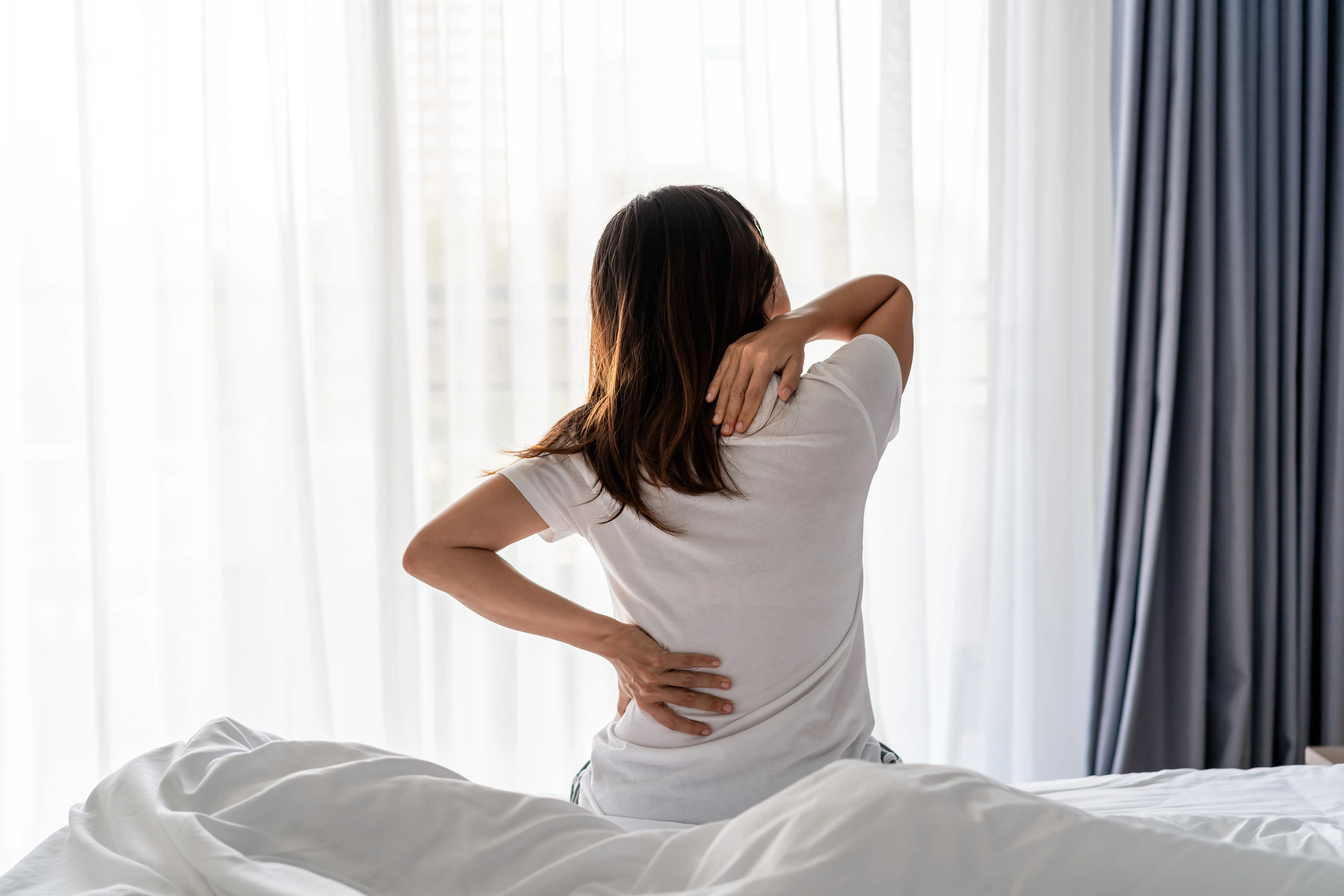Waking up should feel refreshing, but for many, it starts with an ache in the back that lingers throughout the day.
Morning back pain is a common physical health issue, affecting people of all ages and lifestyles. Whether it's caused by poor sleeping posture, an unsupportive mattress, or underlying health conditions, waking up in discomfort can set the wrong tone for the day.
In this article, we’ll explore how sleep works, why back pain occurs in the morning, how common it is, and what steps can be taken to prevent or alleviate it.
Understanding Morning Back Pain

Morning back pain is common and often caused by poor sleep posture, an unsupportive mattress, or muscle stiffness from inactivity. Underlying conditions like arthritis, herniated discs, or fibromyalgia can also contribute.
Learn more about the Best mattresses for Back Pain.
Why Does Back Pain Occur in the Morning?
Morning back pain can result from poor sleeping positions, an unsupportive mattress, or prolonged immobility during sleep, leading to stiffness. Inflammatory conditions like arthritis can worsen pain due to overnight inflammation buildup.
Stress-related muscle tension may also contribute to discomfort. Additionally, underlying issues, such as herniated discs or spinal stenosis, can cause persistent morning pain requiring medical attention, which will be discussed later.
How Common is Morning Back Pain?
Morning back pain is more prevalent than many people realize. Up to 80% of adults experience back pain at some point in their lives, with a significant percentage of them reporting stiffness or discomfort in the morning.
Individuals over 30 are more likely to experience morning back pain due to natural spinal changes and muscle stiffness. People with sedentary lifestyles or jobs that require prolonged sitting are at higher risk of developing back pain due to weakened core muscles and poor sleep posture.
Common Causes of Morning Back Pain

Waking up with back pain can be frustrating, but understanding the root causes can help prevent and manage discomfort. Here are some of the most common factors that contribute to morning back pain:
Poor Sleeping Posture
The way you sleep plays a crucial role in spinal health. Sleeping in awkward positions can strain the spine and surrounding muscles, leading to stiffness and pain in the morning. Common problematic positions are discussed later in this article.
Unsupportive Mattress or Pillow
An old, sagging, or overly firm mattress can contribute to back pain by failing to support the natural curvature of the spine. Similarly, using the wrong pillow can strain the neck and upper back, leading to discomfort that extends down the spine.
An unsupportive sleep surface can contribute to back pain—a mattress that is too soft may cause the spine to sink into an unnatural position, while one that is too firm can create pressure points leading to stiffness. Similarly, an improper pillow that fails to support the neck can disrupt spinal alignment, increasing discomfort.
Learn more about How To Choose a Suitable Mattress.
Stress
Emotional stress often leads to difficulty sleeping and muscle tension, particularly in the shoulders and lower back. This tension can persist overnight, resulting in morning stiffness and pain. Stress-related bruxism (teeth grinding) can also contribute to neck and back discomfort.
Pregnancy
Pregnant women often experience back pain, especially in later stages, due to hormonal changes that loosen ligaments and joints, increased weight adding strain to the lower back, and sleeping positions that put pressure on the spine. Using a pregnancy pillow and maintaining proper sleeping posture can help alleviate discomfort.
Underlying Health Conditions
Several medical conditions can cause or worsen morning back pain:
- Degenerative Disc Disease: As we age, the spinal discs lose hydration and elasticity, leading to stiffness and discomfort, particularly after prolonged periods of inactivity, such as sleep.
- Herniated Discs: A slipped or bulging disc can put pressure on nearby nerves, causing pain, numbness, or tingling sensations, which may be worse after lying down for extended periods.
- Arthritis: Conditions like osteoarthritis and rheumatoid arthritis can lead to joint inflammation and stiffness, making morning movements especially painful. Learn more about the Best Mattresses for Arthritis
- Fibromyalgia: Fibromyalgia is a chronic pain disorder that causes widespread musculoskeletal pain, which is often most intense upon waking due to prolonged periods of muscle inactivity.
- Sciatica: Sciatica is a compressed or irritated sciatic nerve that can cause radiating pain from the lower back down through the legs, often worsening in the morning due to prolonged immobility.
- Ankylosing Spondylitis (AS): This inflammatory arthritis primarily affects the spine, leading to stiffness and pain that are typically worse in the morning or after periods of rest.
- Tumors: In rare cases, spinal tumors can cause localized back pain, especially if they press on nerves or the spinal cord. Persistent, unexplained back pain should always be evaluated by a doctor.
Lack of Movement During Sleep and Muscle Stiffness
During sleep, the body remains in a relatively still position for hours. This can cause the muscles and joints to stiffen, making it difficult to move comfortably upon waking. People with sedentary lifestyles may experience this issue more frequently due to weaker back muscles.
Poor Lifestyle Habits
Unhealthy habits like poor sleep posture, lack of exercise, smoking, and excessive screen time can contribute to chronic back pain. Poor posture leads to spinal misalignment, while weak core muscles from inactivity fail to support the back properly.
Smoking reduces blood flow to spinal discs, increasing degeneration; prolonged screen time encourages prolonged sitting and poor posture, worsening discomfort.
How Sleeping Position Affects Back Pain
Your sleeping position plays a major role in spinal alignment and overall back health. Poor posture during sleep can put stress on the spine, leading to stiffness and discomfort in the morning. Choosing the right sleeping position and making adjustments to your sleep setup can help alleviate back pain and promote better rest.
Best Sleeping Positions for Back Pain Relief
These sleeping positions help maintain proper spinal alignment and reduce pressure on the back:
- Sleeping on Your Back With a Pillow Under Your Knees: Back position keeps the spine neutral and reduces strain on the lower back.
- Side Sleeping With a Pillow Between Your Knees: Side sleeping while placing a pillow between your knees helps keep the hips aligned and prevents spinal twisting.
- Fetal Position (For Herniated Discs): Fetal position and curling into a loose fetal position can help open up the space between vertebrae, relieving pressure on the discs.
- Reclined Sleeping (For Lower Back Pain or Sciatica): Sleeping in a slightly reclined position, such as in an adjustable bed or with a wedge pillow, can reduce pressure on the spine.
Worst Sleeping Positions That Cause Back Pain
Avoid these positions if you frequently wake up with back pain:
- Sleeping on Your Stomach: Sleeping on your stomach forces the spine into an unnatural arch and puts strain on the neck and lower back.
- Side Sleeping Without Knee Support: Side sleeping position can lead to hip and lower back misalignment, causing discomfort.
- Sleeping in a Twisted Position: If your upper and lower body are not aligned, it can put stress on your spine and muscles.
- Using Too Many or Too Few Pillows: An improper pillow height can misalign the neck and spine, leading to back pain.
Prevention and Remedies for Morning Back Pain

Waking up with back pain can disrupt your day, but simple lifestyle adjustments can help prevent discomfort and promote spinal health. From choosing the right mattress to improving posture, these strategies can reduce or eliminate morning back pain.
Choose the Right Mattress and Pillow
Your mattress and pillow play a crucial role in maintaining spinal alignment during sleep. Choosing the right ones can prevent back pain and promote better rest.
- Opt for a Medium-Firm Mattress: A medium-firm mattress provides the right balance of support and comfort, helping to keep the spine properly aligned. Too-soft mattresses allow the body to sink in too much, straining the back, while overly firm mattresses can create pressure points and stiffness.
- Use a Pillow That Supports Your Neck: A properly supportive pillow keeps the neck in line with the spine, reducing strain and preventing stiffness or discomfort. Side sleepers may need a thicker pillow to fill the space between the neck and shoulder, while back sleepers benefit from a thinner pillow that maintains a neutral spine position.
- Replace Old Mattresses and Pillows: Over time, mattresses and pillows lose their supportive qualities, leading to poor posture and increased back pain. Most mattresses should be replaced every 7–10 years, while pillows typically need to be changed every 1–2 years to maintain proper support.
Morning Stretching and Exercises for Back Pain Relief
Performing gentle stretches and strengthening exercises in the morning can help loosen tight muscles, improve flexibility, and reduce stiffness caused by prolonged inactivity during sleep.
- Knee-to-Chest Stretch: This movement helps relieve lower back tension by gently stretching the lumbar spine. Lying on your back, bring one knee toward your chest, holding for a few seconds before switching sides.
- Cat-Cow Stretch: A dynamic movement that improves spinal mobility and flexibility. While on all fours, arch your back (cow) and then round it (cat), helping to relieve tension and improve posture.
- Child’s Pose: A gentle yoga stretch that elongates the lower back, relieves stiffness, and promotes relaxation. This position also stretches the hips and promotes better circulation.
- Core Strengthening (Planks, Bridges): Strengthening the core muscles provides essential support for the spine. Planks engage the entire core, while bridges help activate the lower back and glute muscles, reducing pressure on the lumbar region.
- Lower Back Exercises: Targeted movements such as pelvic tilts and spinal twists can improve flexibility, ease stiffness, and promote better back health over time.
Improve Ergonomics and Posture
Poor posture throughout the day can lead to morning back pain. Making small ergonomic adjustments can significantly reduce strain on the spine.
- Use a Supportive Chair: Sitting in a chair with proper lumbar support helps maintain the natural curve of the spine. Keep your feet flat on the floor, and avoid slouching forward.
- Adjust Your Workstation: Position computer screens at eye level to prevent hunching, use a chair with adjustable height, and ensure your arms are at a 90-degree angle when typing to reduce strain.
- Avoid Prolonged Sitting: Sitting for long periods can put stress on the lower back. Take breaks every 30–60 minutes to stand, stretch, and walk around to prevent stiffness and discomfort.
Manage Stress and Relaxation
Stress can contribute to back pain by causing muscle tension, particularly in the shoulders and lower back. Practicing relaxation techniques can help alleviate pain and promote better sleep.
- Practice Deep Breathing or Meditation: Stress management techniques such as deep breathing, mindfulness, or guided meditation can help relax the body and prevent muscle tension.
- Use Heat Therapy or Warm Baths: Applying heat through heating pads, warm compresses, or soaking in a warm bath before bed can improve circulation, relax tight muscles, and ease discomfort.
- Engage in Low-Impact Activities: Activities like yoga, stretching, or walking help relieve tension, improve circulation, and promote overall muscle relaxation, reducing the risk of waking up with back pain.
When to See a Doctor for Morning Back Pain
While occasional morning back pain is common and often linked to lifestyle factors, persistent or severe pain could indicate an underlying medical condition. Knowing when to seek medical attention can help prevent complications and ensure proper treatment.
Signs That Back Pain Might Indicate a Serious Condition
If you experience additional symptoms along with morning back pain, it may indicate a more serious underlying issue requiring medical attention.
- Pain Lasting More Than a Few Weeks: Occasional back pain is common, but if discomfort persists for several weeks without improvement, it could signal a deeper problem such as a chronic condition or structural issue.
- Severe or Worsening Pain: If back pain intensifies over time, even with rest and self-care, it may indicate inflammation, nerve compression, or a more serious spinal disorder that needs evaluation.
- Pain That Radiates Down the Legs: Back pain that spreads into the legs, especially with numbness or tingling, could be a sign of sciatica or nerve compression, which may require targeted treatment.
- Numbness, Tingling, or Weakness: If you experience loss of sensation, tingling, or muscle weakness in your legs, it may indicate nerve damage or spinal cord involvement that requires immediate medical assessment.
- Loss of Bladder or Bowel Control: This is a red flag for cauda equina syndrome, a serious condition where nerve compression in the lower spine affects bladder and bowel function. Immediate emergency care is necessary.
- Unexplained Weight Loss: Unexpected weight loss without changes in diet or activity could indicate a spinal tumor, infection, or another medical condition that needs investigation.
- Fever Along with Back Pain: A persistent fever with back pain may suggest an infection affecting the spine, such as osteomyelitis or a spinal abscess, requiring prompt medical attention.
- Pain That Disrupts Sleep: If back pain worsens at night or constantly wakes you up, it could be linked to conditions like tumors, infections, or inflammatory disorders that need further evaluation.
Diagnostic Tests for Chronic Back Pain
If a doctor suspects an underlying condition, they may order diagnostic tests to determine the cause of chronic back pain.
- X-Rays: These imaging scans help identify bone-related issues such as fractures, spinal misalignment, or arthritis.
- MRI (Magnetic Resonance Imaging): MRI scans provide detailed images of soft tissues, discs, nerves, and spinal structures, helping detect herniated discs, nerve compression, or tumors.
- CT Scan: A CT scan offers a more detailed view of bones and discs in the spine and is often used when X-rays do not provide enough information.
- Electromyography (EMG): This test measures nerve function and can help diagnose conditions like sciatica, neuropathy, or nerve compression caused by spinal disorders.
- Blood Tests: Bloodwork can reveal infections, inflammatory diseases, or autoimmune disorders contributing to chronic back pain.
- Bone Scan: In rare cases, a bone scan may be used to detect fractures, infections, or tumors that affect the spine, especially if other imaging tests are inconclusive.
Medical Treatments for Chronic Back Pain
If morning back pain is caused by an underlying condition, doctors may recommend various treatments, including:
- Physical Therapy: Physical therapy is often the first line of treatment for chronic back pain. A trained therapist can guide patients through targeted strengthening and stretching exercises designed to improve flexibility, reduce muscle stiffness, and enhance spinal stability.
- Medications: Medication can be used to manage pain and inflammation, depending on the severity of symptoms:
- Over-the-counter Pain Relievers: Nonsteroidal anti-inflammatory drugs (NSAIDs) like ibuprofen and naproxen help reduce inflammation, while acetaminophen can provide pain relief.
- Prescription Muscle Relaxants: For more severe pain, doctors may prescribe muscle relaxants to ease muscle spasms or stronger anti-inflammatory medications to reduce swelling and discomfort.
- Corticosteroid Injections: If inflammation is causing significant pain, corticosteroid injections may be administered directly into the affected area to provide temporary relief, often lasting weeks or months.
- Chiropractic Care: Chiropractic adjustments and osteopathic manipulation involve hands-on techniques to realign the spine and relieve pressure on nerves. These treatments can help reduce pain, improve joint mobility, and promote overall spinal health. While some patients experience immediate relief, regular sessions may be needed for lasting benefits.
- Discectomy: This procedure involves removing a portion of a herniated or bulging disc that is pressing on a nerve, causing pain and discomfort. It is commonly performed for conditions like sciatica or severe disc herniation.
- Spinal Fusion: In cases of severe instability or degenerative disc disease, spinal fusion surgery is performed to join two or more vertebrae together, preventing movement between them and reducing pain.
- Laminectomy: If spinal stenosis (narrowing of the spinal canal) is causing nerve compression, a laminectomy may be performed to remove a portion of the vertebra, creating more space for the nerves and reducing pain.
FAQs
Why do I wake up with back pain every morning?
Morning back pain is often caused by poor sleeping posture, an unsupportive mattress, or an underlying condition like arthritis or a herniated disc. Overnight stiffness can also contribute to discomfort. Stretching and improving sleep ergonomics can help alleviate the pain and improve overall spinal health.
Can my mattress be causing my back pain?
Yes, an unsupportive mattress can lead to back pain by failing to keep your spine properly aligned. A mattress that is too soft or too firm may create pressure points or allow the spine to sink unnaturally. Choosing a medium-firm mattress designed for spinal support can help reduce morning pain.
What sleeping positions help prevent back pain?
Sleeping on your back with a pillow under your knees or on your side with a pillow between your knees helps keep the spine aligned. Avoid sleeping on your stomach, as it forces the spine into an unnatural position, increasing strain on the lower back and leading to morning stiffness.
Can pillows contribute to back pain?
Yes, using an incorrect pillow can strain the neck and spine, leading to discomfort. A pillow that’s too high or too flat can misalign the spine. For back sleepers, a medium-thickness pillow is ideal. Side sleepers should use a thicker pillow, while stomach sleepers should opt for a very thin one.
Could an underlying health condition be causing my morning back pain?
Yes, conditions like arthritis, degenerative disc disease, fibromyalgia, or herniated discs can cause morning back pain. Inflammatory conditions like ankylosing spondylitis often worsen with prolonged rest. If pain persists or worsens despite lifestyle changes, consult a doctor for proper evaluation and treatment options.
What can I do to reduce morning back pain?
Stretching before bed and after waking up can help relieve stiffness. Maintaining good posture, sleeping on a supportive mattress, and using ergonomic pillows are also beneficial. Regular exercise, core strengthening, and weight management help support spinal health. If pain continues, a healthcare provider may recommend physical therapy or other treatments.
Conclusion
Waking up with back pain can disrupt your day, but simple adjustments can provide relief. Improving sleep posture, using a supportive mattress, and incorporating morning stretches can ease discomfort. If pain persists, consult a doctor to rule out underlying conditions and find the best treatment for long-term back health.
Dom Abraham
As the lead content writer at Sleepiverse. Dom pours his heart into writing mattress reviews, bedding product reviews, and medically-reviewed health articles. Dom is from Portugal and likes to spend his free time writing on the beach as it gives him a sense of comfort. Aside from writing mattress reviews in front of the soothing beach view, Dom likes to experiment with new amazing food ideas.


